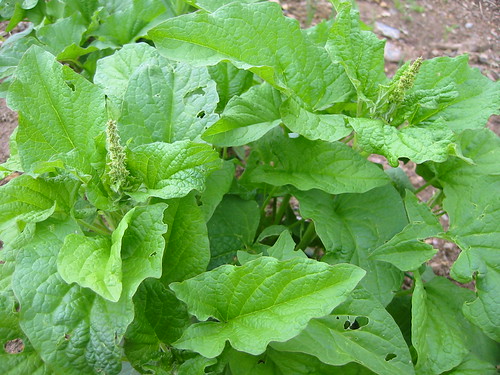
This culinary pot herb, Chenopodium bonus-henricus, a native of central and southern Europe is alleged, like that other pernicious weed Ground Elder, to have been spread to northern Europe and the UK by the Romans as they conquered and colonised their way to an empire. Many of the common names associated with it across Europe make mention of Good Henry, the Germans call it Guter Heinrich and the French chénopode Bon Henri but only the British have added the King part, presumably in honour of Henry VIII. It's also known as Mercury.
As a member of the Chenopod family it has among its relations fat hen, goosefoot and quinoa, all of which plants have been or still are used for food for humans and animals since neolithic times. It has other benefits for the gardener. It's extremely easy to grow, surviving almost anywhere and it's perennial, returning year after year with no need to save seed or regularly replant. However, it's not great to eat. Although undeniably nutritious the flavour is bland and the texture often coarse. A sustenance food for times of famine.
It grows to about 60cm tall with a spread of about 30cm but clumps can expand considerably further than that. The leaves are arrow shaped, up to 10cm long and they are slightly textured, almost hairy when young.
To grow it all you need is a patch of land to put it in. It is hardy and tenacious, my patch survived several years of neglect, bind weed and couch grass encroachment before I moved it to its pleasant quarters in the vegetable plot.
Although it can be started from seed, sown where it is to grow and allowed to grow on for a full year before harvest, it is probably easier to get a small plant to keep as a novelty in one corner of the herb bed. If you like the taste and want more plants divide the clump in spring and plant out in good garden soil. It will take a little shade for part of the day and may produce more tender leaves during summer as a benefit of it. It is said that 30 plants will feed a family of four, but I suggest they'd have to be pretty hungry to prefer this to spinach or chard.
Cooking is easy, take a bundle of young leaves any time between the end of April and August and use them as you would spinach, lightly cooked with some salt and fat to add moistness. Eating them raw is certainly possible but many authorities warn of an excess of saponins and oxalic acid so it's probably best not to do this often. The method of cooking I have yet to try is to take the flower stems and buds and steam them like asparagus. I'll report back on that in a week or two!
Medicinally it has been used as a gentle laxative and the leaves have been boiled and used as a poultice for infected sores and abscesses but this is pretty much standard usage for all non-poisonous green herbs and there is no evidence of any particular benefit to be gained by using this plant. One reference suggests it was popular as a cure for indigestion. It has been used a dye plant, producing greens and golds.
It does make good animal feed, chickens are particularly fond of it and its relatives so if you don't fancy it yourself you might treat the chooks.
2 comments:
Not great to eat?! I think this is a lovely vegetable. It has a hint of spinach with a slight crunch to the stems and flower head, so a bit like broccoli as well.
I'm still not convinced it's the world's greatest but after a bit of experimenting with the cooking I've upgraded my rating to 7.5 out of 10 which ain't bad.
Recipe here:
http://thecatofstripes.blogspot.com/2008/06/polenta-e-minestra.html
Post a Comment